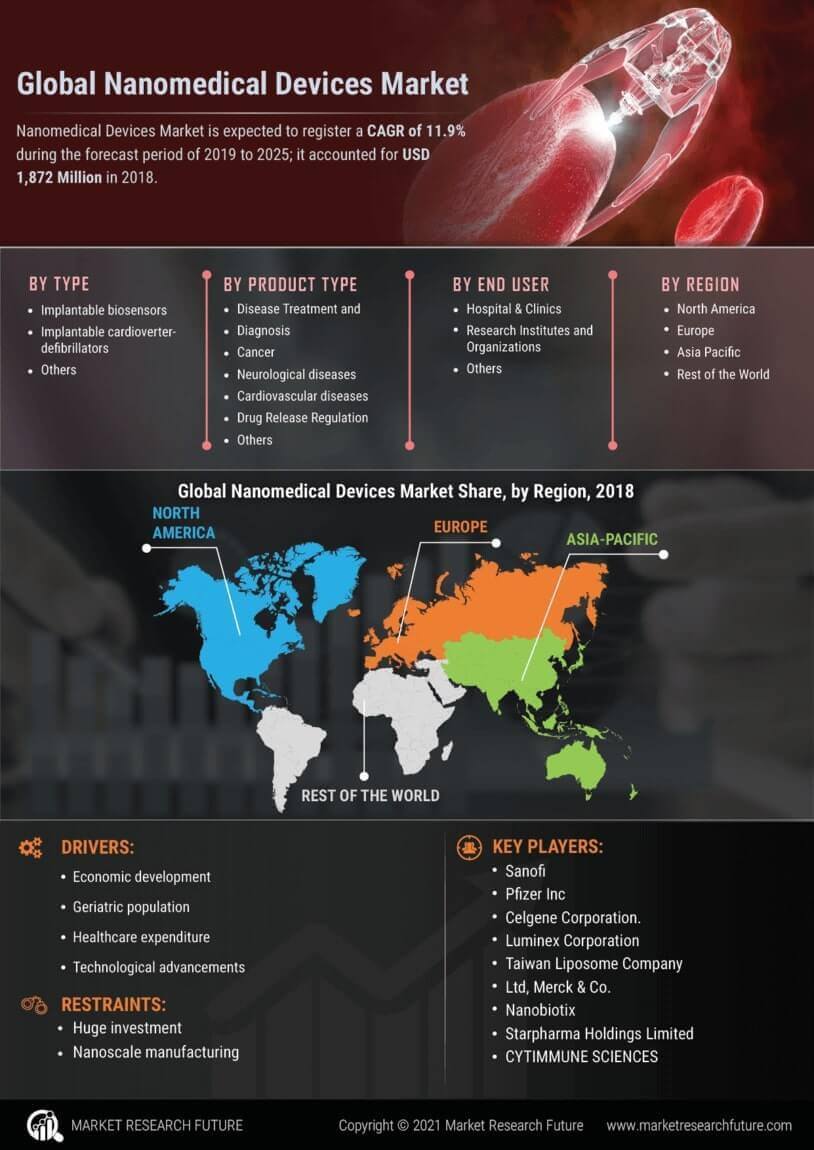Growing Prevalence of Chronic Diseases
The rising prevalence of chronic diseases is a critical factor propelling the Nanomedical Devices Market. Conditions such as diabetes, cardiovascular diseases, and cancer are becoming increasingly common, necessitating advanced medical solutions. Nanomedical devices offer innovative approaches to disease management, including targeted therapies and real-time monitoring systems. For instance, the integration of nanotechnology in glucose monitoring devices has improved accuracy and patient compliance. Market forecasts suggest that the chronic disease management segment will account for a substantial share of the nanomedical devices market, with an expected growth rate of 9% over the next few years. This trend underscores the importance of developing effective nanomedical solutions to address the growing healthcare challenges posed by chronic illnesses in the Nanomedical Devices Market.
Technological Advancements in Nanotechnology
The Nanomedical Devices Market is experiencing a surge in technological advancements that enhance the efficacy and precision of medical devices. Innovations in nanotechnology, such as the development of nanoparticles for targeted drug delivery, are revolutionizing treatment methodologies. For instance, the use of nanoscale materials allows for the creation of devices that can operate at the cellular level, potentially improving patient outcomes. According to recent estimates, the market for nanomedical devices is projected to reach USD 200 billion by 2026, driven by these technological innovations. Furthermore, advancements in imaging techniques and biosensors are enabling earlier disease detection, which is crucial for effective treatment. As these technologies continue to evolve, they are likely to play a pivotal role in shaping the future of the Nanomedical Devices Market.
Regulatory Support for Nanomedical Innovations
Regulatory support is emerging as a vital driver for the Nanomedical Devices Market. Regulatory bodies are increasingly recognizing the potential of nanotechnology in healthcare and are establishing frameworks to facilitate the approval of innovative devices. This supportive environment encourages manufacturers to invest in the development of new nanomedical solutions. Recent initiatives aimed at streamlining the approval process for nanomedical devices are likely to enhance market entry for novel products. As a result, the market is expected to grow at a rate of 11% annually, reflecting the positive impact of regulatory advancements. Furthermore, collaboration between regulatory agencies and industry stakeholders is fostering a better understanding of nanotechnology's benefits and risks, ultimately promoting safer and more effective devices in the Nanomedical Devices Market.
Rising Demand for Minimally Invasive Procedures
The growing preference for minimally invasive procedures is a key driver in the Nanomedical Devices Market. Patients increasingly favor treatments that reduce recovery time and minimize surgical risks. Nanomedical devices, such as nanobots and micro-surgical tools, are designed to perform complex procedures with minimal incisions, thereby enhancing patient comfort and satisfaction. Market analysis indicates that the minimally invasive surgical devices segment is expected to grow at a compound annual growth rate of 10% over the next five years. This trend is further supported by advancements in imaging and navigation technologies that facilitate precise interventions. As healthcare providers adopt these innovative solutions, the demand for nanomedical devices is likely to escalate, reflecting a shift towards patient-centric care in the Nanomedical Devices Market.
Increased Investment in Research and Development
Investment in research and development is a significant driver of growth in the Nanomedical Devices Market. Governments and private entities are allocating substantial resources to explore the potential of nanotechnology in medicine. This influx of funding is fostering innovation and accelerating the development of new nanomedical devices. For example, research initiatives focusing on cancer treatment using nanocarriers have shown promising results, leading to increased interest from pharmaceutical companies. The market is projected to witness a growth rate of 12% annually, driven by these R&D efforts. Additionally, collaborations between academic institutions and industry players are enhancing knowledge transfer and expediting the commercialization of novel devices. As a result, the Nanomedical Devices Market is poised for robust expansion, fueled by ongoing research endeavors.

















Leave a Comment